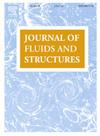Impact of a porous structure placed at the sea-bed in wave scattering around ice floes
IF 3.4
2区 工程技术
Q1 ENGINEERING, MECHANICAL
引用次数: 0
Abstract
The present work examines the two-dimensional wave scattering problem involving a pair of ice floes of finite length separated by a finite gap over a finite ocean depth with a thick porous structure lying on an impermeable sea-bed. The physical and mathematical considerations of wave propagation through thick porous structures are analysed by analysing the interaction between the wave and the porous medium. Following linear water wave theory, the boundary value problem (BVP) is solved using the matched eigenfunction expansion method. Numerical results on various hydrodynamic coefficients are presented by varying the parameters pertaining to the porous structure and the ice floe. The reflection coefficient oscillates with an increase in the length of the first floe in the direction of the incoming waves and settles down when the length of the second floe increases. Maximum transmission is experienced when the gap between the two floes is substantial, since a higher gap allows more waves to pass through, thereby increasing the rate of transmission. The present study shows that an increase in the porosity shifts the phase of the maximum reflection, whereas a thick porous structure diminishes the maximum reflection coefficient by absorbing wave energy. With an increase in rigidity, the reflection coefficient increases, and at higher compressive force, the energy absorption increases, and consequently, the reflection reduces.
放置在海床上的多孔结构对浮冰周围波浪散射的影响
本文研究了一个二维波散射问题,涉及一对有限长度的浮冰,在有限的海洋深度上被有限的间隙隔开,它们具有厚的多孔结构,位于不透水的海床上。通过分析波与多孔介质的相互作用,分析了波在厚多孔结构中传播的物理和数学问题。根据线性水波理论,采用匹配特征函数展开法求解水波边值问题。通过改变多孔结构和浮冰的相关参数,得到了不同水动力系数的数值结果。反射系数随入射波方向上第一个流体长度的增加而振荡,随第二个流体长度的增加而趋于稳定。当两个浮冰之间的间隙很大时,可以经历最大的传输,因为较大的间隙允许更多的波通过,从而增加传输速率。研究表明,孔隙度的增加使最大反射相位发生偏移,而较厚的多孔结构通过吸收波能而减小最大反射系数。随着刚度的增加,反射系数增大,在较高的压缩力下,能量吸收增大,反射减小。
本文章由计算机程序翻译,如有差异,请以英文原文为准。
求助全文
约1分钟内获得全文
求助全文
来源期刊

Journal of Fluids and Structures
工程技术-工程:机械
CiteScore
6.90
自引率
8.30%
发文量
173
审稿时长
65 days
期刊介绍:
The Journal of Fluids and Structures serves as a focal point and a forum for the exchange of ideas, for the many kinds of specialists and practitioners concerned with fluid–structure interactions and the dynamics of systems related thereto, in any field. One of its aims is to foster the cross–fertilization of ideas, methods and techniques in the various disciplines involved.
The journal publishes papers that present original and significant contributions on all aspects of the mechanical interactions between fluids and solids, regardless of scale.
 求助内容:
求助内容: 应助结果提醒方式:
应助结果提醒方式:


